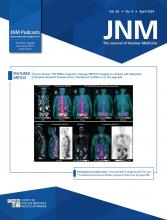Abstract
The aim of this study was to identify a folate receptor-alpha (FRα)-selective PET agent, potentially suitable for the selection of patients that could profit from FRα-targeted therapies. The 6R- and 6S-isomers of 18F-aza-5-methyltetrahydrofolate (MTHF) were assessed regarding their binding to the FRα and FRβ, expressed on cancer and inflammatory cells respectively, and compared to 18F-AzaFol, the folic acid-based analogue. Methods: FR selectivity was investigated using FRα-transfected (RT16) and FRβ-transfected (D4) CHO cells. The cell uptake of 18F-folate tracers was investigated and receptor-binding affinities were determined with the non-radioactive analogues. In vitro autoradiography of the 18F-folate tracers was performed using RT16 and D4 tissue sections. Biodistribution studies and PET/CT imaging of the radiotracers were performed with mice bearing RT16 and D4 xenografts. Results: The uptake of 18F-6R-aza-5-MTHF into RT16 cells was high (62 ± 10% of added activity) but much lower when using D4 cells (5 ± 2%). FRα selectivity of 18F-6R-aza-5-MTHF was further demonstrated by its ~43-fold higher binding affinity to the FRα (IC50 = 1.8 ± 0.1 nM) than to the FRβ (IC50 = 77 ± 27 nM). The uptake of 18F-6S-aza-5-MTHF and 18F-AzaFol was equal in both cell lines (52–70%) and similar affinities to the FRα (IC50 = 2.1 ± 0.4 and 0.6 ± 0.3 nM, respectively) and FRβ (0.8 ± 0.2 and 0.3 ± 0.1 nM, respectively) were determined. The autoradiography signal obtained with 18F-6R-aza-5-MTHF was 11-fold more intense for RT16 than for D4 tissue sections. Biodistribution data showed high uptake of 18F-6R-aza-5-MTHF in RT16 xenografts (81 ± 20% IA/g, 1 h p.i.), but significantly lower accumulation in D4 xenografts (7.3 ± 2.1% IA/g, 1 h p.i.) which was also visualized using PET. The uptake of 18F-6S-aza-5-MTHF and 18F-AzaFol was similar in RT16 (53 ± 10% IA/g and 45 ± 2% IA/g, respectively) and D4 xenografts (77 ± 10% IA/g and 52 ± 7% IA/g, respectively). Conclusion: This study demonstrated FRα selectivity for 18F-6R-aza-5-MTHF but not for 18F-6S-aza-5-MTHF and 18F-AzaFol. This characteristic, together with its favorable tissue distribution, make 18F-6R-aza-5-MTHF attractive for clinical translation to enable detection of FRα-positive cancer while preventing undesired accumulation in FRβ-expressing inflammatory cells.
- Animal Imaging
- Molecular Imaging
- Oncology: GYN
- PET/CT
- Radiopharmaceuticals
- 18F
- 5-methyltetrahydrofolate
- FRα selectivity
- PET
- folate receptor
- Copyright © 2021 by the Society of Nuclear Medicine and Molecular Imaging, Inc.







